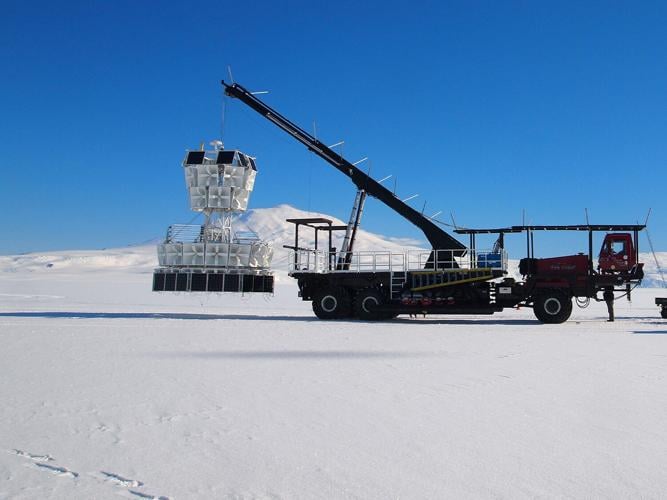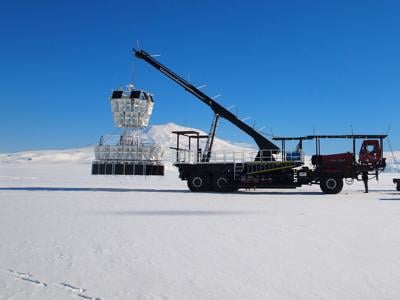
The unusual radio pulses were detected by the Antarctic Impulsive Transient Antenna (ANITA) experiment, a range of instruments flown on balloons high above Antarctica that are designed to detect radio waves from cosmic rays hitting the atmosphere. (Stephanie Wissel/Penn State./CC4 via SWNS)
By Dean Murray
Scientists are baffled by weird signals detected beneath Antarctica.
A cosmic particle detector designed to pick up rays from space instead recorded a series of bizarre signals from under the ice.
Penn State, whose scientists are part of the international research group, said the signals "defy the current understanding of particle physics."
The unusual radio pulses were detected by the Antarctic Impulsive Transient Antenna (ANITA) experiment, a range of instruments flown on balloons high above Antarctica that are designed to detect radio waves from cosmic rays hitting the atmosphere.
The goal of the experiment is to gain insight into distant cosmic events by analysing signals that reach the Earth.
However, rather than reflecting off the ice, the signals — a form of radio waves — appeared to be coming from below the horizon, an orientation that cannot be explained and may hint at new types of particles or interactions previously unknown to science.

(Stephanie Wissel/Penn State./CC4 via SWNS)
“The radio waves that we detected were at really steep angles, like 30 degrees below the surface of the ice,” said Stephanie Wissel, associate professor of physics, astronomy and astrophysics who worked on the ANITA team searching for signals from elusive particles called neutrinos.
She explained that by their calculations, the anomalous signal had to pass through and interact with thousands of kilometres of rock before reaching the detector, which should have left the radio signal undetectable because it would have been absorbed into the rock.
“It’s an interesting problem because we still don't actually have an explanation for what those anomalies are, but what we do know is that they're most likely not representing neutrinos,” Wissel said.
Neutrinos, a type of particle with no charge and the smallest mass of all subatomic particles, are abundant in the universe. Usually emitted by high-energy sources like the sun or major cosmic events like supernovas or even the Big Bang, there are neutrino signals everywhere. The problem with these particles, though, is that they are notoriously difficult to detect, Wissel explained.

(Stephanie Wissel/Penn State./CC4 via SWNS)
“You have a billion neutrinos passing through your thumbnail at any moment, but neutrinos don't really interact,” she said. “So, this is the double-edged sword problem. If we detect them, it means they have travelled all this way without interacting with anything else. We could be detecting a neutrino coming from the edge of the observable universe.”
Analysis revealed the other detectors did not register anything that could have explained what ANITA detected, which led the researchers to describe the signal as “anomalous,” meaning that the particles causing the signal are not neutrinos, Wissel explained.
The signals do not fit within the standard picture of particle physics, and while several theories suggest that it may be a hint of dark matter, the lack of follow-up observations with IceCube and Auger really narrows the possibilities, she said.
Penn State has built detectors and analysed neutrino signals for close to 1ten years, Wissel explained, and added that her team is currently designing and building the next big detector.
The new detector, called PUEO, will be larger and better at detecting neutrino signals and it will hopefully shed light on what exactly the anomalous signal is.
“My guess is that some interesting radio propagation effect occurs near ice and also near the horizon that I don't fully understand, but we certainly explored several of those, and we haven't been able to find any of those yet either,” Wissel said. “So, right now, it's one of these long-standing mysteries, and I'm excited that when we fly PUEO, we'll have better sensitivity. In principle, we should pick up more anomalies, and maybe we'll actually understand what they are. We also might detect neutrinos, which would in some ways be a lot more exciting.”
The researchers published their results in the journal Physical Review Letters.









